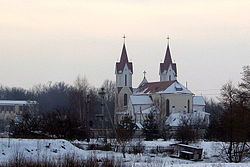Eldership Švenčionys eldership Granted city rights 1961 Local time Monday 2:26 AM | First mentioned 1800 Population 4,963 (2011) | |
 | ||
Capital of Švenčionys district municipalityŠvenčionys eldership Weather 8°C, Wind N at 5 km/h, 95% Humidity Municipality Švenčionys District Municipality | ||
Jensen jt600 lithuania ven ionys
Švenčionys ( pronunciation , known also by several alternative names) is a town located 84 kilometers (52 mi) north of Vilnius in Lithuania. It is the capital of the Švenčionys district municipality. As of 2011, it had population of 4,963 of which about 17% is part of the Polish minority in Lithuania.
Contents
- Jensen jt600 lithuania ven ionys
- Map of C5A0venC48Dionys Lithuania
- Etymology
- History
- Notable residents
- References
Map of %C5%A0ven%C4%8Dionys, Lithuania
Etymology
There are two established hypotheses about the etymology of the Švenčionys name: one that it is the name of the nearby lake Šventas (literally: saint) with the addition of the Lithuanian suffix -onys; another is that it is derived from the personal name, Švenčionis. In other languages the name is rendered as Polish: Święciany, Belarusian: Свянцяны/Svjacjany, Russian: Свентяны/Sventiany, Yiddish: סווינציאַן /Svintsyán, and German: Swenziany.
History
One of the oldest towns in the Grand Duchy of Lithuania, the settlement was a major center of Nalšia. Grand Duke Vytautas settled Lipka Tatars in the town and built a Catholic church in 1414. The place grew from the 14th to 16th centuries, becoming the site of a local court and monastery. From 1801 the town was part of the Russian Vilna Governorate and grew significantly after completion of the Saint Petersburg – Warsaw Railway in 1862, but eventually lost competition to Švenčionėliai, which grew around the train station. At the turn of the 20th century the town had one Greek Orthodox church and one Roman Catholic church.During the 1812 French invasion of Russia, Napoleon stayed in the town for 12 hours to write orders and receive an envoy from the King of Naples. The town was one of the main centers of the November Uprising (1830–1831) in Poland and Lithuania against the Russian Empire. During World War I, it was the location of the German Sventiany Offensive.
The city was part of the Second Polish Republic for most of the interwar period. It had a significant Jewish population (according to the 1897 Russian census – 52%), but during World War II. Under German occupation, the Švenčionys Ghetto was established. It operated from July 1941 to April 1943. At its peak, the ghetto housed some 1,500 prisoners. The Jewish inhabitants were deported and murdered. It was a powiat centre in Wilno Voivodeship as Święciany during Polish rule between 1920-1939.
The Soviets placed it firstly in part of Vileyka Oblast of the Belorussian SSR in 1939 but then incorporated into Lithuanian SSR in 1940. In 1942 the Lithuanian Security Police murdered around 1,200 Poles in the village. Most of the municipal area remained part of the Lithuanian SSR except the Ashmyany region which was reincorporated into Belarus in 1944.
